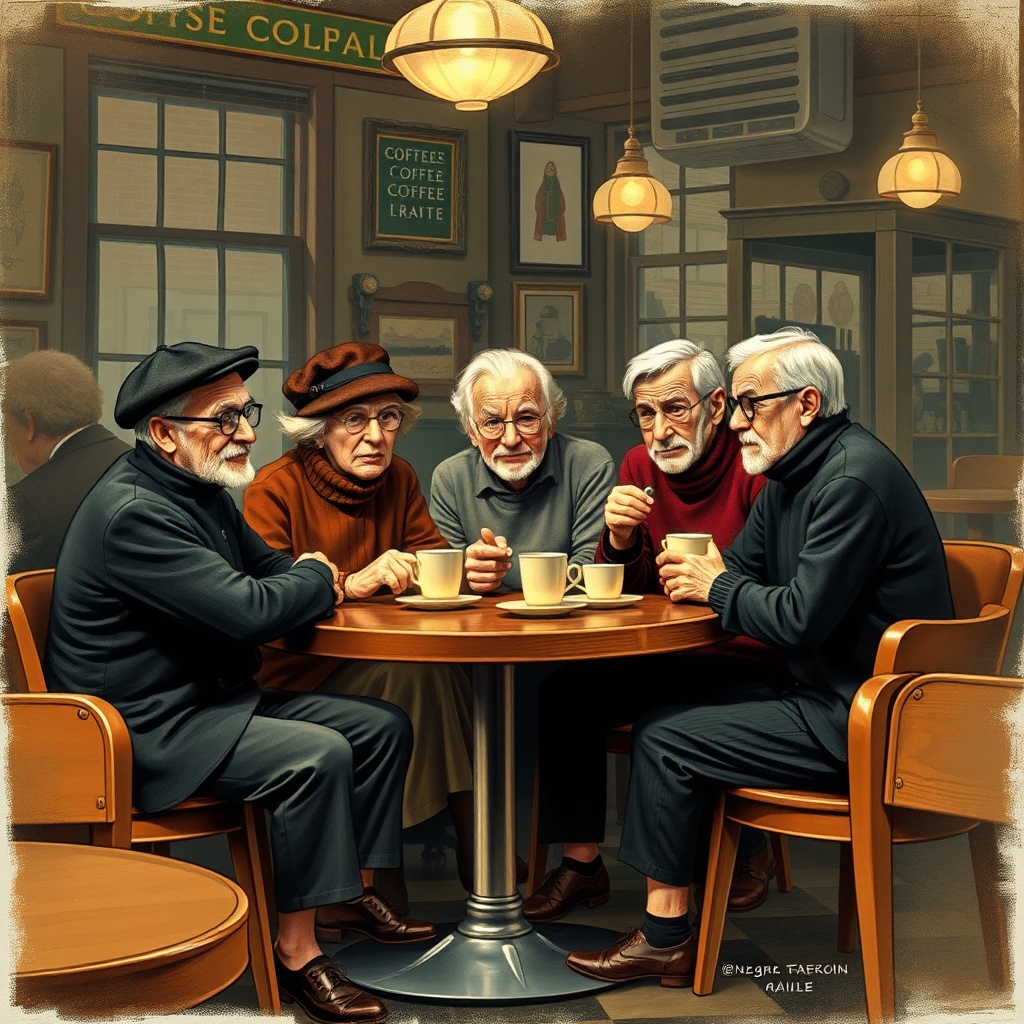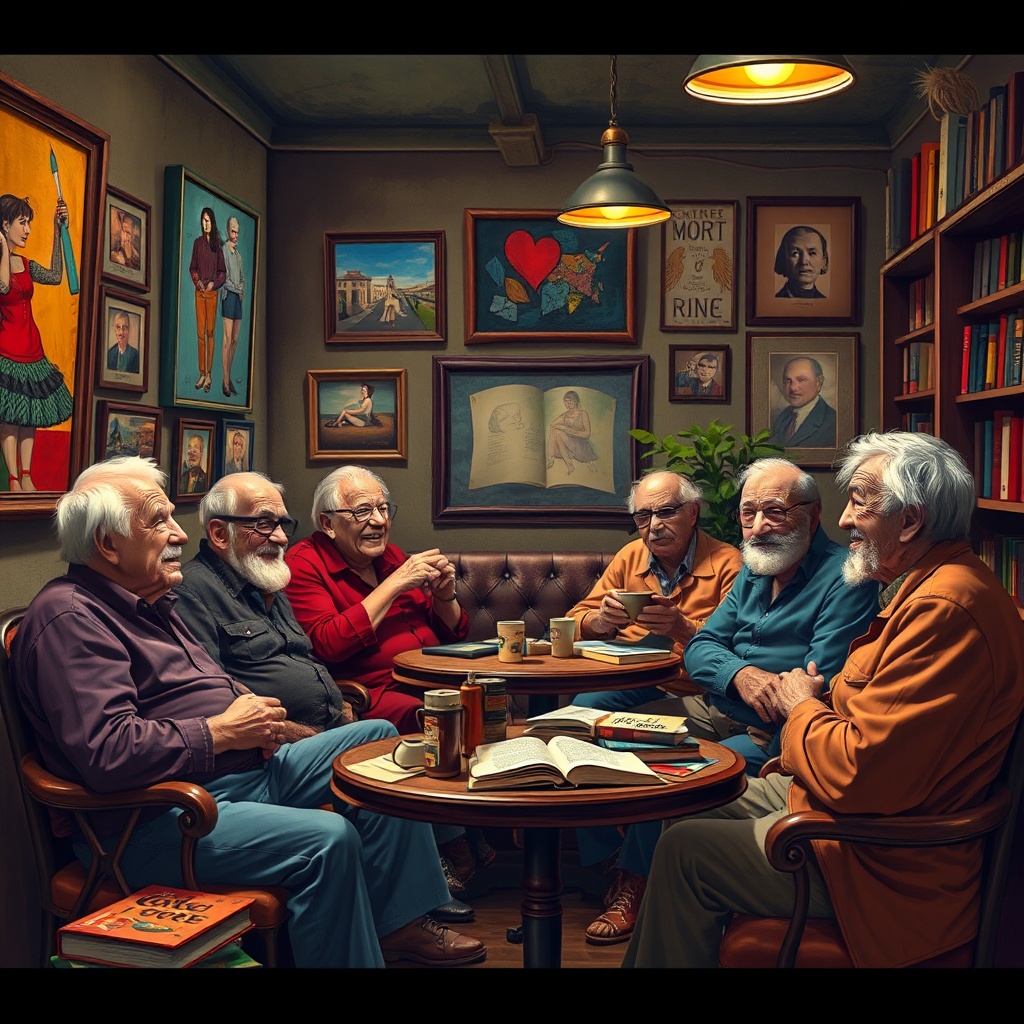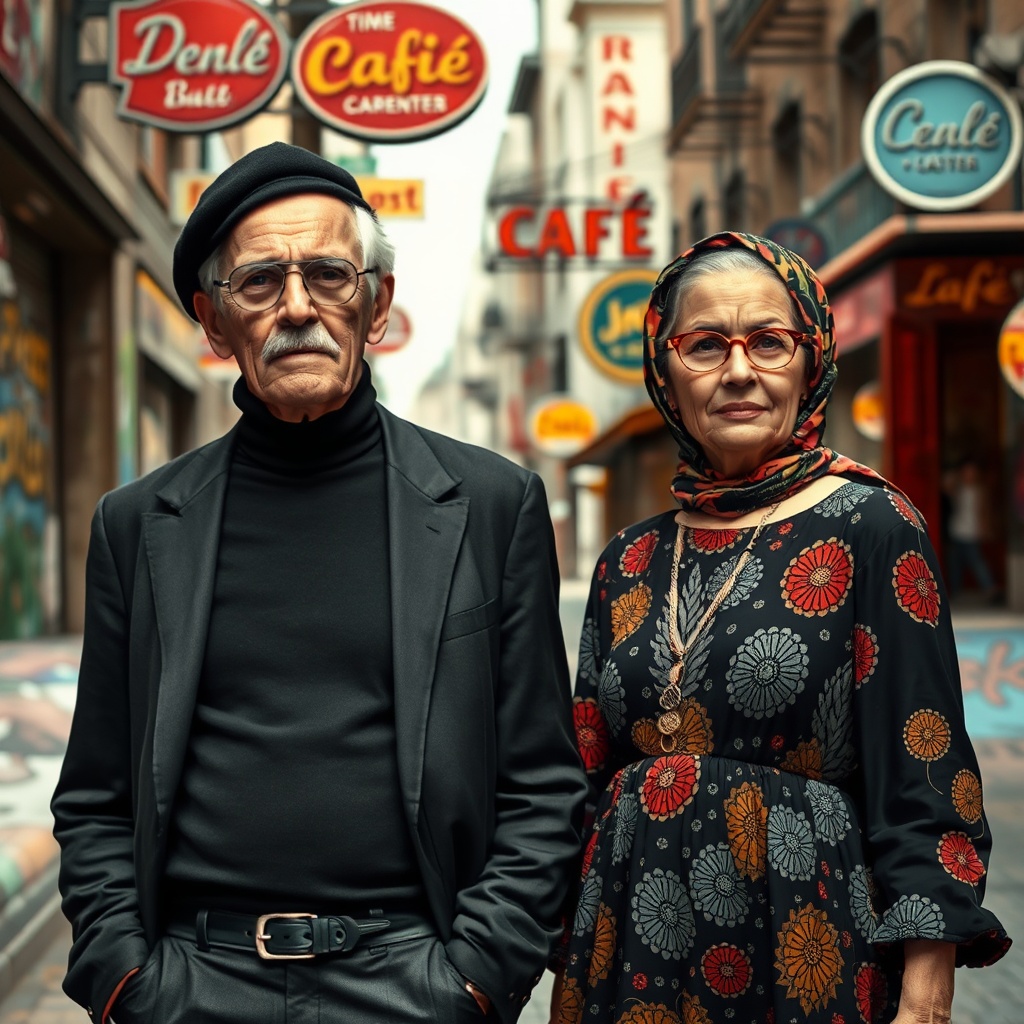Unveiling the Allure: How 1960s Beatnik Fashion Redefined Individuality

The 1960s were a time of transformation and rebellion, a decade where societal norms were challenged, and individuality flourished. At the forefront of this cultural revolution was the Beatnik movement, which brought forth a unique fashion style that was not only about clothing but also a profound statement of identity.
The Essence of Beatnik Fashion
Beatnik fashion was characterized by its artistic flair and a strong sense of personal expression. Let’s explore the key elements that made this style iconic:
- Black Attire: The signature color of the Beatniks was black. It symbolized sophistication and a break from traditional fashion norms.
- Berets and Scarves: Accessories like berets and scarves were often worn to add a touch of artistic flair and individuality.
- Statement Clothing: Items such as turtlenecks, wide-legged pants, and oversized sweaters were common, reflecting comfort and a casual yet chic attitude.
- Footwear: Ankle boots and loafers were popular, providing a laid-back yet stylish look.
Influence of Literature and Art
Beatnik fashion was heavily influenced by literature and art. Writers like Jack Kerouac and Allen Ginsberg, along with artists such as Andy Warhol, contributed to the movement’s ethos. Their works celebrated nonconformity and intellectual freedom, inspiring the way individuals expressed themselves through fashion.
The Impact on Individuality
Beatnik fashion was more than just a trend; it was a powerful means of declaring one’s identity. Here are some ways it redefined individuality:
- Breaking Gender Norms: Beatnik fashion blurred the lines between gender, allowing men and women to share styles and express themselves freely.
- Rejection of Materialism: The Beatniks often rejected mainstream consumer culture, choosing instead to create a personal style that was unique and meaningful.
- Art as a Lifestyle: Fashion became an extension of artistic expression, where every piece of clothing was chosen to convey a message.
Legacy of Beatnik Fashion
The legacy of Beatnik fashion continues to influence modern styles. Its emphasis on individuality and self-expression resonates today, encouraging people to embrace their uniqueness.
As we reflect on the allure of 1960s Beatnik fashion, it’s evident that this movement was not just about clothing; it was about creating a cultural identity that challenged the status quo. The bold choices made by Beatniks paved the way for future generations to explore and express their individuality in ways that are still celebrated today.
Canvas of the Streets: The Impact of Art and Literature on Beatnik Style

The Beatnik Movement: A Cultural Canvas
The 1960s was not just a decade of social upheaval; it was a vibrant tapestry woven from threads of art, literature, and an insatiable quest for self-expression. The Beatniks, a group of writers and artists, embraced unconventional lifestyles and aesthetics that influenced fashion profoundly. Their style was not merely a reflection of their personalities but a canvas of the streets, embodying the essence of rebellion and creativity.
Artistic Influences on Beatnik Fashion
The art scene of the 1960s provided fertile ground for the Beatnik aesthetic. Artists like Jackson Pollock and Andy Warhol challenged traditional notions of art, and this challenge spilled over into the world of fashion. The use of bold colors, abstract patterns, and experimental designs became synonymous with the Beatnik style.
- Abstract Expressionism: The chaotic yet beautiful brush strokes of Pollock inspired many to embrace spontaneity.
- Pop Art: Warhol’s vibrant prints encouraged the use of bold colors in everyday clothing.
- Surrealism: Influences from artists like Salvador Dalí introduced dreamlike elements into fashion.
Literary Inspirations
Literature played a crucial role in shaping the Beatnik identity. Writers such as Jack Kerouac and Allen Ginsberg not only penned groundbreaking works but also set the tone for a rebellious lifestyle that was reflected in their clothing choices.
- Kerouac’s ‘On the Road’: This iconic novel encapsulated the spirit of freedom and exploration, inspiring Beatniks to adopt a casual yet chic style.
- Ginsberg’s ‘Howl’: The raw emotion and candid expression in his poetry resonated with a generation seeking authenticity in their appearance.
Fashion Elements of the Beatnik Style
Beatnik fashion was characterized by several key elements that combined artistic expression with a sense of rebellion:
- Black Turtlenecks: A staple that symbolized sophistication and nonconformity.
- Berets: Often worn tilted, these hats became a symbol of artistic identity.
- Wide-Legged Pants: Comfortable yet stylish, they allowed for freedom of movement and self-expression.
- Statement Accessories: Items like chunky jewelry and oversized sunglasses completed the look.
Interactive Reflection
As we explore the impact of art and literature on Beatnik style, consider your own journey through fashion and self-expression. What elements of the Beatnik aesthetic resonate with you? How have art and literature influenced your personal style throughout the years?
Conclusion: A Lasting Legacy
The Beatnik movement was more than just a fashion statement; it was a cultural revolution that challenged societal norms and celebrated individuality. The echoes of their artistic expression can still be felt today, reminding us of the power of creativity in shaping our identities.
From Paris to Greenwich Village: A Global Perspective on Beatnik Fashion

Introduction to Beatnik Fashion
The 1960s were not just a decade of music and revolution; they also marked a significant turning point in the world of fashion. Beatnik fashion emerged as a bold statement of individuality and artistic expression, transcending geographical boundaries from Paris to Greenwich Village.
Paris: The Heart of Artistic Revolution
In the post-war era, Paris became a melting pot for artists, writers, and intellectuals. The Beat Generation found inspiration in the streets of Montparnasse and the cafes of Saint-Germain-des-Prés. Key fashion elements included:
| Fashion Item | Description |
|---|---|
| Black Turtlenecks | A staple for both men and women, symbolizing sophistication and rebellion. |
| Wide-Leg Pants | Comfortable and chic, often paired with simple tops. |
| Statement Accessories | Bold hats, large sunglasses, and chunky jewelry that complemented the minimalist clothing. |
Greenwich Village: The Epicenter of Beat Culture
The vibe of Greenwich Village in New York City was electric. It became a hub for writers and musicians who embraced the beatnik lifestyle. Here, fashion took on a more casual, yet equally expressive, form:
| Fashion Item | Description |
|---|---|
| Berets | A symbol of artistic flair, often worn tilted to one side. |
| Leather Jackets | Worn by both genders as a sign of toughness and nonconformity. |
| Vintage Dresses | Floral and patterned dresses that highlighted femininity while maintaining a relaxed vibe. |
A Global Perspective
Beatnik fashion wasn’t confined to just Paris and Greenwich Village. It resonated globally, influencing and being influenced by various cultures. For example:
London: The Mod movement took cues from beatnik aesthetics, intertwining them with a more polished British style.
Tokyo: Young Japanese artists embraced beatnik fashion, incorporating traditional elements into modern outfits.
Mexico City: Artists blended vibrant colors with the monochromatic beatnik palette, creating a unique fusion.
The Legacy of Beatnik Fashion
Even today, the influence of beatnik fashion remains evident in contemporary styles. From the use of sustainable fabrics to the embrace of individuality, the essence of the 1960s continues to inspire. As you reflect on this journey through the bold elegance of beatnik fashion, consider how those choices shaped not only personal identity but also cultural landscapes worldwide.
Take a moment to think about your own experiences with fashion. How did the styles of your youth shape your identity? Share a memory or a story about a piece of clothing that defined a moment in your life.
Rebel with a Cause: The Political Undertones of Beatnik Aesthetics
Understanding the Beatnik Movement
The Beatniks emerged in the 1950s and flourished in the 1960s, characterized by their distinctive style and a strong sense of rebellion. This movement was not merely about aesthetics but was deeply intertwined with political and social issues of the time.
Fashion as a Form of Protest
Beatnik fashion, which included items like black turtlenecks, berets, and wide-legged pants, was a statement against the conformist culture of the post-war era. By choosing to dress in a way that was unconventional, they expressed their discontent with the political landscape, particularly the Cold War sentiments that pervaded society.
Artistic Expression and Cultural Commentary
Many Beatniks were also artists and writers who used their talents to challenge the status quo. They believed in the power of art to spark change and provoke thought. The beats often gathered in coffeehouses, reading poetry and discussing philosophy, making their gatherings a form of political discourse.
The Influence of Jazz and Literature
Jazz music played a significant role in Beatnik culture, serving as both inspiration and a backdrop for their gatherings. Artists like Jack Kerouac and Allen Ginsberg incorporated elements of jazz into their works, promoting a sense of spontaneity and freedom. This relationship between music and literature further emphasized the need for artistic expression as a means of social critique.
Women in the Beatnik Movement
Women in the Beatnik scene, such as Diane di Prima and Amiri Baraka‘s partner, were not just muses but active participants in the political and artistic landscape. They challenged traditional gender roles and used their voices to advocate for women’s rights, showcasing that the rebellion was inclusive and multifaceted.
Legacy of Beatnik Fashion and Politics
The legacy of the Beatnik movement is still felt today. Their rejection of materialism and embrace of individuality paved the way for later movements, including the counterculture of the 1960s. Beatnik fashion has influenced modern styles and continues to inspire those who wish to express their political beliefs through their clothing choices.
Final Thoughts
As we revisit the bold elegance of Beatnik fashion, it is crucial to recognize the political undertones that defined this cultural phenomenon. The Beatniks were indeed rebels with a cause, using their unique aesthetics as a powerful form of artistic expression against an often oppressive society.
The Timeless Palette: Key Colors and Patterns that Shaped the Beatnik Look
The Influence of Color in Beatnik Fashion
Beatnik fashion was not just about clothing; it was a statement of individuality and rebellion against the mainstream. The colors chosen by beatniks were often deep, rich, and moody, reflecting the intellectual and artistic nature of the movement.
Key Colors of the Beatnik Era
Some of the most iconic colors that defined the beatnik look include:
Black: The quintessential color of the beatniks, representing mystery and sophistication.
White: Often used in contrast to black, signifying purity and a blank canvas for artistic expression.
Deep Red: A color of passion, symbolizing the revolutionary spirit of the era.
Earthy Tones: Shades like browns and greens that connected the beatniks to nature and their anti-establishment sentiments.
Patterns That Made a Statement
Patterns were also essential in creating the bold beatnik aesthetic. Here are some patterns you might recall:
Stripes: Often seen in turtlenecks and dresses, stripes embodied the effortless chicness that beatniks strived for.
Geometric Shapes: Influenced by modern art, these patterns added an avant-garde touch to their outfits.
Floral Prints: While less common, floral patterns symbolized a connection to the natural world and were often used in less formal settings.
Think back to your own experiences with beatnik fashion. Did you have a favorite color or pattern that you wore during this vibrant time? Perhaps a black turtleneck paired with a deep red scarf? Share your memories and consider how these colors and patterns made you feel.
The Lasting Impact of Beatnik Colors
The colors and patterns of the beatnik fashion have had a profound impact on modern fashion. They continue to inspire designers and artists today, reminding us of a time when self-expression was at the forefront of culture. As you reflect on the beatnik movement, consider how these timeless colors can still resonate in your wardrobe today.
Living History: Personal Stories from Those Who Embraced the Beatnik Movement
Introduction to Beatnik Culture
The 1960s were a time of revolution, not just in politics but in fashion, music, and art. The Beatnik movement emerged as a reaction against the mainstream values of the time, promoting individuality, creativity, and a deep appreciation for the arts. Many individuals embraced this movement, creating a rich tapestry of stories and experiences that continue to resonate today.
Personal Stories: A Tapestry of Experiences
Let’s dive into some of the personal stories shared by those who lived through the Beatnik era. Each account reflects not only the personal journey of these individuals but also the collective spirit of the Beatnik culture.
Story 1: A Fashion Statement
Margaret, 78 recalls her first encounter with Beatnik fashion. “I remember walking into a small boutique in Greenwich Village. The black turtlenecks, berets, and flowing skirts spoke to my soul. It was more than clothing; it was a statement of who I wanted to be. I felt free for the first time.”
Story 2: Poetry and Expression
James, 82 shares his passion for poetry. “The coffee houses were alive with creativity. I would recite my poems alongside others. It wasn’t just about the words; it was about connecting with others who felt the same way. The Beatniks taught me that my voice mattered.”
Story 3: Artistic Revolutions
Linda, 80 reflects on her journey as an artist. “I painted every day, inspired by the world around me. The Beatnik movement encouraged me to express my views on society through my art. It was a revolution of colors and emotions.”
Community and Connection
The Beatnik movement was not just about individual expression; it created a community of like-minded individuals. Many found a sense of belonging that transcended traditional social barriers. Arthur, 85 shares, “We were a family. We gathered in parks, discussed literature, and supported one another’s artistic endeavors. It was a beautiful time.”
Reflecting on the Impact
As we listen to these stories, it becomes evident that the Beatnik movement was about more than fashion or art; it was about a profound cultural shift. It encouraged individuals to challenge societal norms and embrace their true selves.
Today, the echoes of the Beatnik movement can still be felt. It serves as a reminder of the power of art and individuality in shaping our world. The stories of those who embraced this movement offer valuable lessons for future generations.
Accessorize Your Spirit: Jewelry and Hats That Embodied Beatnik Attitude
Embrace the Beatnik Vibe
The Beatnik movement of the 1960s was not just about literature and music; it was a full-blown cultural revolution that seeped into the fashion of the time. If you find yourself reminiscing about those vibrant days, let’s take a closer look at how jewelry and hats became essential elements of expressing the Beatnik attitude.
Jewelry: A Statement of Individuality
Layering and Boldness: The key to Beatnik style was layering. Think bold, chunky necklaces made of wooden beads, semi-precious stones, or even vintage finds. These pieces spoke volumes about the wearer’s personality and artistic spirit. How about diving into your old jewelry box and discovering those hidden gems?
Symbolism and Meaning: Jewelry in the Beatnik era often symbolized more than just aesthetics. Pieces were often handmade or sourced from various cultures, representing a worldly outlook. Consider wearing a necklace with a peace symbol or a crescent moon pendant to evoke that same spirit.
Hats: The Crown of the Beatnik
The Iconic Beret: Perhaps the most iconic accessory of the Beatnik era was the beret. It wasn’t just a hat; it was a statement. Wearing a beret tilted to the side could instantly transform your outfit into a work of art. Do you own a beret? How does it make you feel when you wear it?
Wide-Brimmed and Feathers: Beyond berets, wide-brimmed hats made a striking statement. Often adorned with feathers or unique embellishments, these hats were a nod to the bohemian lifestyle. Picture yourself in a wide-brimmed hat, standing in a sunlit park, feeling the spirit of freedom wash over you.
Crafting Your Own Beatnik Look
As you reflect on the Beatnik style, consider how you can incorporate these accessories into your current wardrobe. Mixing vintage pieces with modern attire can recreate that artistic vibe. Perhaps you can host a small gathering with friends, sharing stories of the past while showcasing your unique accessories. What are some of your favorite accessories from that era?
Capturing the Essence of Beatnik Fashion
Ultimately, the essence of Beatnik fashion lies in its spirit of rebellion, creativity, and authenticity. By accessorizing with jewelry and hats that embody this attitude, you are not just completing an outfit; you are expressing a rich tapestry of cultural history and personal identity. Are you ready to embrace your inner Beatnik?
Fashion as Protest: The Cultural Significance of Beatnik Attire
Understanding Beatnik Fashion
Do you remember the essence of the 1960s? The Beatnik movement was not just a cultural phase; it was a rebellion against the mainstream. Beatnik fashion emerged as a powerful form of protest against societal norms, reflecting a desire for freedom and individuality. The iconic black turtlenecks, berets, and cigarette pants were more than mere clothing—they were statements, challenging the status quo.
The Elements of Beatnik Attire
Let’s take a closer look at some key elements that defined this striking style:
Black Turtlenecks: A staple that signified sophistication and a break from convention.
Cigarette Pants: These fitted trousers allowed for ease of movement and were a nod to the androgynous look.
Berets: Often worn tilted to one side, symbolizing a connection to the artistic community.
Bold Accessories: Large glasses, beaded necklaces, and scarves added to the unique flair.
Consider this: every article of clothing worn by a Beatnik was a protest against conformity. By choosing to dress in a way that defied societal expectations, individuals communicated their dissatisfaction with the political climate, materialism, and war. How do you think such clothing choices influenced those around them?
The Cultural Impact
The Beatnik fashion movement paved the way for future countercultures. It inspired subsequent generations to express their beliefs through clothing. This was not limited to the 1960s; can you see elements of Beatnik style in today’s fashion? Think about the bohemian looks that echo this rebellion.
Reflection on Personal Style
What does your fashion sense say about you? Many elderly individuals today have lived through significant cultural shifts. Reflecting on your personal style during the 1960s, how did it resonate with your beliefs? Did you feel empowered by your choices? This connection to your past can be a celebration of identity.
As we revisit the bold elegance of Beatnik fashion, we uncover a rich tapestry of artistic expression and cultural revolution. The attire worn by Beatniks was not merely for aesthetics; it was a profound statement of freedom, identity, and resistance. Engage with these memories and consider how fashion can continue to be a form of protest even today.
Reviving the Beat: Modern Interpretations of 1960s Beatnik Fashion for Today’s Era
The 1960s marked a significant shift in fashion, especially with the emergence of the Beatnik movement. Known for their artistic expression and nonconformity, Beatniks embraced a style that was both bold and elegant. Today, we explore how we can revive this iconic fashion for modern audiences, especially for those who appreciate the rich cultural history behind it.
Key Elements of Beatnik Fashion
- Monochrome Palettes: Predominantly black and white outfits that reflect simplicity and sophistication.
- Casual Chic: Comfortable yet stylish pieces like turtlenecks, berets, and cigarette pants.
- Artistic Accessories: Statement jewelry, scarves, and distinctive footwear that add character.
Modern Interpretations
Let’s dive into some modern interpretations of these classic elements:
| Beatnik Element | Modern Twist |
|---|---|
| Monochrome Outfits | Incorporating bold patterns with a choice of subtle colors to maintain elegance. |
| Cigarette Pants | Pairing with oversized sweaters or fitted blazers for a contemporary look. |
| Berets | Using different materials like felt or wool, and experimenting with colors. |
| Statement Jewelry | Opting for sustainable brands that focus on handmade artistic designs. |
Reviving the Beatnik Spirit
As we consider these modern interpretations, it’s essential to reflect on the spirit of the Beatnik movement:
- Individuality: Emphasize personal style over trends.
- Artistic Expression: Use fashion as a medium to express your beliefs and creativity.
- Community: Engage with like-minded individuals through fashion events or local art shows.
Conclusion: Embracing the Beatnik Aesthetic Today
Reviving Beatnik fashion isn’t just about the clothes; it’s about adopting a mindset that values creativity and authenticity. By infusing modern elements into classic styles, we can honor the legacy of the 1960s while making it relevant for today’s era. Embrace the beat, and let your style tell your story!
A Symphonic Blend: Music’s Role in the Evolution of Beatnik Fashion
The 1960s were a revolutionary time, not just in politics and culture, but also in fashion. The Beatniks, a group of artists and intellectuals, embraced a unique style that was deeply intertwined with the music of the era. Let’s take a moment to explore how music shaped the Beatnik fashion movement.
The Soundtrack of a Generation
Jazz was the heartbeat of the Beatniks. Artists like Charles Mingus and John Coltrane influenced not only the music scene but also the fashion choices of those who identified with the movement. The improvisational nature of jazz resonated with the Beatnik philosophy of freedom and self-expression.
Fashion Inspired by Rhythm
As jazz clubs became the gathering places for Beatniks, their fashion evolved alongside the music. Here are some key elements:
- Dark, Simple Colors: Much like the moody tones of jazz, Beatniks often wore black turtlenecks, berets, and trousers.
- Bohemian Accents: The influence of folk music brought in elements like flowing fabrics and ethnic prints.
- Accessories: Oversized sunglasses and scarves were popular, serving as a nod to the mysterious allure of jazz musicians.
Folk Music and the Changing Times
The rise of folk music in the late ’50s and early ’60s, with icons like Bob Dylan and Joan Baez, brought a new wave of influence. Their emphasis on social issues and personal expression resonated with the Beatnik ethos:
- Casual Styles: The laid-back, comfortable attire of folk singers led to a more approachable Beatnik look.
- Denim and Vintage: The rebellion against the norm encouraged the adoption of denim jackets and vintage clothing.
An Artistic Expression
Beatnik fashion was not just about clothing; it was an artistic expression that intertwined with the music being played. Poetry readings and musical performances became platforms for showcasing fashion. The lines between the visual arts, music, and fashion blurred:
- Poetry and Performance: Open mic nights and poetry slams were often accompanied by live music, where the attire reflected the artistic intent.
- Visual Artists: Many Beatniks were painters or sculptors, and their work often inspired the styles worn by their peers.
Today, we still see the echoes of Beatnik fashion in modern styles. The influence of music on fashion continues to be a vibrant topic. As we reminisce about the past, think about how music has shaped your own fashion choices. How has your favorite song influenced what you wear?
Music played an essential role in the evolution of Beatnik fashion, creating a symphony of style that resonated with the cultural revolution of the 1960s. Reflect on how these elements come together to create a unique expression of identity, creativity, and freedom.
